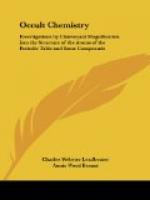The research once started in the way I have described was seen to be intensely interesting. Mrs. Besant almost immediately co-operated with Mr. Leadbeater in its further progress. Encouraged by the success with hydrogen, the two important gases, oxygen and nitrogen, were examined. They proved to be rather more difficult to deal with than hydrogen but were manageable. Oxygen was found to consist of 290 minor atoms and nitrogen of 261. Their grouping will be described later on. The interest and importance of the whole subject will best be appreciated by a rough indication of the results first attained. The reader will then have more patience in following the intricacies of the later discoveries.
The figures just quoted were soon perceived to have a possible significance. The atomic weight of oxygen is commonly taken as 16. That is to say, an atom of oxygen is sixteen times heavier than an atom of hydrogen. In this way, all through the table of atomic weights, hydrogen is taken as unity, without any attempt being made to estimate its absolute weight. But now with the atom of hydrogen dissected, so to speak, and found to consist of 18 somethings, while the atom of oxygen consisted of 290 of the same things, the sixteen to one relationship reappears: 290 divided by 18 gives us 16 and a minute decimal fraction. Again the nitrogen number divided by 18 gives us 14 and a minute fraction as the result, and that is the accepted atomic weight of nitrogen. This gave us a glimpse of a principle that might run all through the table of atomic weights. For reasons having to do with other work, it was impossible for the authors of this book to carry on the research further at the time it was begun. The results already sketched were published as an article in the magazine then called Lucifer, in November, 1895, and reprinted as a separate pamphlet bearing the title “Occult Chemistry,” a pamphlet the surviving copies of which will one day be a recognised vindication of the method that will at some time in the future be generally applied to the investigation of Nature’s mysteries. For the later research which this volume deals with does establish the principle with a force that can hardly be resisted by any fair-minded reader. With patience and industry—the authors being assisted in the counting in a way that will be described (and the method adopted involved a check upon the accuracy of the counting)—the minor atoms of almost all the known chemical elements, as they are commonly called, were counted and found to bear the same relation to their atomic weights as had been suggested by the cases of oxygen and nitrogen. This result throws back complete proof on the original estimate of the number of minor atoms in hydrogen, a figure which ordinary research has so far entirely failed to determine. The guesses have been widely various, from unity to many hundreds, but, unacquainted with the clairvoyant method, the ordinary physicist has no means of reaching the actual state of the facts.




